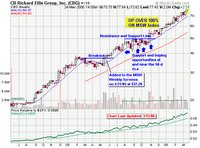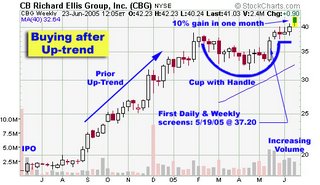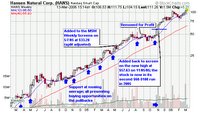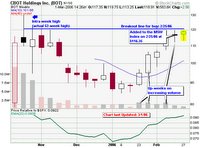I have been arguing (going back and forth) with a “so-called” investor on another forum and he questioned my trading methods and claimed I would lose 76% if I took 8 consecutive 8% losses. Knowing me, I had to breathe deeply, release the anger from a person who knows nothing about position sizing and teach him a simple math lesson. The following example is simplified to allow you to understand what is happening. In the real world, things are a bit more complicated with commissions, emotions, slippage and the like.
Enjoy the position sizing example. It shows you how you can lose 80% of the time (worse case scenario); yet still come out a slight winner.
If I start with $100,000 and lose 8 consecutive trades at 8% (only risking 3% of capital with 8% stop loss), this is what it looks like:
$100,000 portfolio
3% risk per trade
8% stop loss
1st Trade:Risk will be $3000 = ($100,000*3%)
Amount to Trade at 8% stop: $37,500 = ($3000 / 8%)
An 8% stop loss will cost me $3000
2nd Trade:Risk will be $2,910 = ($97,000*3%)
Amount to Trade at 8% stop: $36,375 = ($2,910 / 8%)
An 8% stop loss will cost me $2,910
3rd Trade:Risk will be $2,822 = ($94,090*3%)
Amount to Trade at 8% stop: $35,283 = ($2,822 / 8%)
An 8% stop loss will cost me $2,822
4th Trade:Risk will be $2,738 = ($91,267*3%)
Amount to Trade at 8% stop: $34,225 = ($2,738 / 8%)
An 8% stop loss will cost me $2,738
5th Trade:Risk will be $2,655 = ($88,525*3%)
Amount to Trade at 8% stop: $33,198 = ($2,655 / 8%)
An 8% stop loss will cost me $2,655
6th Trade:
Risk will be $2,576 = ($85,873*3%)
Amount to Trade at 8% stop: $32,202 = ($2,576 / 8%)
An 8% stop loss will cost me $2,576
7th Trade:Risk will be $2,498 = ($83,297*3%)
Amount to Trade at 8% stop: $31,236 = ($2,498 / 8%)
An 8% stop loss will cost me $2,498
8th Trade:Risk will be $2,423 = ($80,798*3%)
Amount to Trade at 8% stop: $30,299 = ($2,423 / 8%)
An 8% stop loss will cost me $2,423
Total loss after 8 trades: $19,201
This loss totals 19% (minus commissions etc…)
TRADE #9:Risk will be $2,351 = ($78,374*3%)
Amount to Trade at 8% stop: $29,390 = ($2,351 / 8%)
An 8% stop loss will cost me $2,351
**This trade ends with a 40% gain: $11,756 = ($29,390*40%)**
Original amount: $78,374 + $11,756 =
$90,130
TRADE #10:
Risk will be $2,703 = ($90,130*3%)
Amount to Trade at 8% stop: $33,787 = ($2,703 / 8%)
An 8% stop loss will cost me $2,703
**This trade ends with a 30% gain: $10,136 = ($33,787*30%)**
Total portfolio worth: $100,266WOW – a profit with 8 consecutive losing trades and 2 winning trades!
That is a 20% winning percentage but it gave me an end result of a slight profit!
This is how money management works!
Now just imagine have a winning percentage of 40% or greater and cutting some of those losses at less than 8%, your portfolio could easily gain 50% or more in one year with a 40% winning percentage based on simple position sizing!
This is how TRUE investors and traders take money out of Wall Street.
Piranha
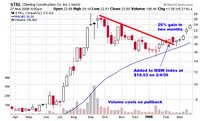 I started to cover Sterling Construction (STRL) on the MSW Index on February 4, 2006 at $18.93 as it gained support at the 200-d m.a. I purchased shares for myself at $19.05 the following week. The stock almost violated a mental sell stop but I held due to support below and have been rewarded with a 26% gain in less than two months. I wrote an extensive blog post here about price targets and retracement levels for STRL, including a chart.
I started to cover Sterling Construction (STRL) on the MSW Index on February 4, 2006 at $18.93 as it gained support at the 200-d m.a. I purchased shares for myself at $19.05 the following week. The stock almost violated a mental sell stop but I held due to support below and have been rewarded with a 26% gain in less than two months. I wrote an extensive blog post here about price targets and retracement levels for STRL, including a chart.

